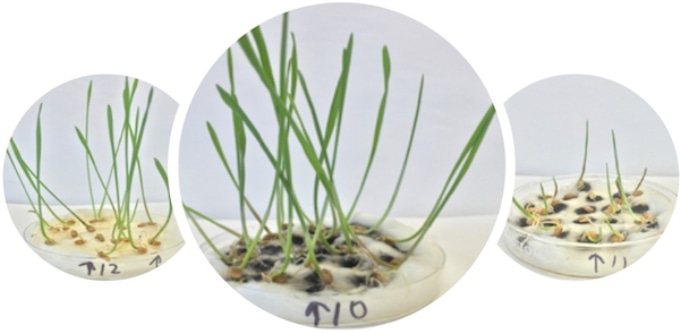Dec 7 2017
Researchers from the Rice University have discovered that when purified carbon nanotubes were introduced to wheatgrass strains it had an advantageous impact on their early growth . However, the same nanotubes were found to pose considerable harm when contaminants were present.
 Purified single-walled carbon nanotubes dispersed in water promoted greater plant growth (center) than the nanomaterial-free control (left) after eight days of an experiment at Rice University. Feeding plants tetrahydrofuran with the nanotubes (right) produced the opposite effect, stunting plant growth. CREDIT: Seung Mook Lee.
Purified single-walled carbon nanotubes dispersed in water promoted greater plant growth (center) than the nanomaterial-free control (left) after eight days of an experiment at Rice University. Feeding plants tetrahydrofuran with the nanotubes (right) produced the opposite effect, stunting plant growth. CREDIT: Seung Mook Lee.
In order to investigate the prospective toxicity of the nanoparticles on wheatgrass, the plant was grown in the Rice lab of chemist Andrew Barron inside a hydroponic garden. Astonishingly, the researchers discovered that one kind of particle distributed in water assisted faster and greater growth of wheatgrass.
The researchers assume that the outcomes are due to the natural hydrophobic, or water-repellent, nature of the nanotubes, which seemingly helped in the increased intake of water by the plants in one experiment.
The study has been published in the Royal Society of Chemistry’s Environmental Science: Nano journal.
The small-scale research was performed in the lab with the understanding that the industrial synthesis of nanotubes will naturally result in the extensive distribution of the particles into the environment. The research has indicated the fast growth of nanoparticles in the market in fabrics, drugs, military weapons, cosmetics, and water filters, where several thousand tons of products are manufactured per year.
Barron stated that in spite of the extensive application of nanoparticles, very few scientists have analyzed the effect of natural or man-made environmental nanoparticles on the growth of plants.
The team planted wheatgrass seeds in a number of replicates in cotton wool and introduced dispersions comprising purified single-walled nanotubes, raw single-walled or multi-walled nanotubes, or iron oxide nanoparticles that were similar to leftover catalyst normally attached to nanotubes. Tetrahydrofuran (THF), an industrial solvent, or water was used to make the solutions. A few seeds were treated as controls and fed with THF or pure water.
At the end of 8 days, it was found that the wheatgrass plantings fed with purified single-walled nanotubes distributed in water had improved germination rate and shoot growth, which was nearly 13% larger than plants grown in plain water. The researchers also found that raw single- and multi-walled nanotubes and particles distributed in one of the two solutions had insignificant impact on the growth of the plants.
Purified single-walled nanotubes dispersed in THF decelerated the development of the plants by 45% as against single-walled nanotubes dispersed in water, indicating that the nanotubes function as carriers for the harmful substance.
According to Barron, the disturbing thing is that the merging of single-walled nanotubes with organic contaminants such as industrial chemicals, pesticides, or environmental solvents might lead to concentration and immobilization of the harmful substances and increase in their intake by plants.
Barron stated that this restricted research could not determine whether carbon nanotubes distributed in the environment—and possibly in plants—will go up the food chain and cause harm to humans.
In contrast, the team indicated that it would be advantageous to study whether hydrophobic substrates that imitate the positive impacts of single-walled nanotubes can be used for highly efficacious channeling of water to seeds.
“Our work confirms the importance of thinking of nanomaterials as part of a system rather in isolation,” stated Barron. “It is the combination with other compounds that is important to understand.”
The lead author of the study is Seung Mook Lee, a former visiting student research assistant from Memorial High School in Houston who is at present an undergraduate student at the University of California, Berkeley. Pavan Raja, Rice research scientist, and Gibran Esquenazi, a graduate student, are the co-authors of the study. Barron is the Charles W. Duncan Jr.–Welch Professor of Chemistry and a professor of materials science and nanoengineering at Rice and the Sêr Cymru Chair of Low Carbon Energy and Environment at Swansea University, Wales (United Kingdom).
The study was supported by the Welsh Government Sêr Cymru Program and the Robert A. Welch Foundation.